A lot of people look at my marketing technology landscape graphic and protest, “There’s too damn much software in marketing!” To many, it’s inconceivable that a marketer would ever be able to manage working with more than a handful of software products — and ideally, they’d work with just one.
But I believe this overlooks the true pervasiveness of software.
So as a little thought exercise, I’d like to demonstrate how most marketers are already using over 100 software programs on a regular basis. Not only do they not break into a sweat with this Herculean feat — most of the time they don’t even notice (feel free to scroll past the italics once you concede the point):
At the top of the pyramid, there are applications that we naturally think of as “marketing software” such as CRM (probably with extra “apps” installed), marketing automation, web analytics (likely several), your website CMS, possibly a separate blog system like WordPress. If you’re using WordPress, how many plug-ins do you have installed? Each one is small software program. On your website or blog, perhaps you’re running little scripts (i.e., software) for A/B testing, mouse tracking, social sharing, personalization, live chat, discussion threads, feedback surveys, calling tracking, ad retargeting, etc. — possibly all coordinated through a tag management system. Ever run an SEO audit or a security analysis on your website? More software.
Maybe you have software for content marketing management and social media management. There’s software you run for digital advertising — perhaps a DSP and a DMP, a keyword research tool, click fraud detection, but maybe just direct ad placement services (again, software) on Google, Facebook, LinkedIn, Twitter. Audience research services (i.e, software) like Comscore and Nielsen? Maybe a marketing resource management (MRM) or digital asset management (DAM) system.
But then there’s all the marketing software products you run locally on your computer to do marketing tasks, such as Excel, Word, PowerPoint (or their Google App equivalents). A calendar app. Your email software. Image and design software, such as Adobe’s creative suite. Software for recording and editing videos, screencasts, podcasts. Software for hosting your own video conferences and webinars — and multiple client programs for accessing other people’s. Software like Box or Dropbox for file sharing. Corporate applications for financials, expense tracking, HR benefit management, recruiting (possibly multiple services), reserving conference rooms, backup, anti-virus protection, etc.
And, of course, your computer’s most important application, a web browser — you may actually have two or three — which is a gateway to a whole other range of web-based services, such as Google Search, Google Maps, Twitter, YouTube, Facebook, LinkedIn, Wikipedia. Maybe Pinterest, Tumblr, Instagram, Meet-up, Quora, SlideShare. OpenTable to make reservations for a business lunch. Airline apps (or their websites) to book business travel. Perhaps TripIt to track it all for you.
There’s all the software in your smartphone — dozens of apps there, no doubt — versions of email, Twitter, Facebook, LinkedIn, web browser, calculator. Your camera app (a great marketing tool!). An SMS text app. The “phone app” within your smartphone to make calls and check your voicemail. A GPS app to find where you need to go. (You may also have a phone on your desk, probably running VoIP, which is also a software program).
But wait, there’s more. The operating system of your laptop, which automatically launches dozens of little software programs that run in the background every time you boot up. The operating systems of each of your mobile devices. All the software on the wireless stations, routers, and firewalls that network you with the world.
I’ve made my point (and, apologies, probably beaten it to death), but I could list dozens of other software programs that marketers interact with every week, directly or indirectly related to their jobs. As Marc Andreessen predicted: software has eaten the world.
However, there are three important takeaways from this exercise:
1. Ambient software is growing faster than conscious software.
Most software programs we use are what I call ambient software — they’re either invisible or you don’t consciously think of them as software when you use them.
You don’t think about running Google’s search software. You just type in a query, probably directly in your browser toolbar, and results pop up on your screen. The near “invisibility” of this software is one of its best features, making it effortless to use. But let’s acknowledge: Google’s search engine is actually an incredibly sophisticated piece of software and that has become essential to the work marketers do every day.
Many websites that marketers use fall into this category — especially the panoply of social media. You may object that this is a sleight-of-hand, conflating sites with software. But that was the entire basis of the Web 2.0 movement and web-based software-as-a-service (SaaS). That movement succeeded largely because it’s not consciously perceived as software — just cool websites or mobile apps that help you get things done.
Such ambient software has expanded tremendously over the past decade — far more than conscious software that we explicitly recognize as such (although that’s growing too).
Major enterprise software products tend to be the most recognized conscious software — but perhaps only to the degree that your team has a significant stake in its use. If you’re in marketing, your marketing automation or CRM software fits this profile. Your company’s HR management platform, however, may slip into your subconscious.
The same goes for local group software that you share only within your team — for instance, if your team uses a web-based tool like Trello to manage your agile marketing backlog. Since we have to get buy-in from multiple participants, these software choices certainly start out front-of-mind. Over time though, they too can fade into habit.
Then there’s all the personal software we use on our own devices — including all the app-like websites out there that we use, such as Google and LinkedIn. A lot of it is free, cheap, or bundled, so we don’t even have a “moment of purchase” to consciously recognize that we’re adopting a new piece of software. Most of this is ambient software from our first touchpoint onward.
The biggest category by far though is invisible software — operating systems, networks, firmware, etc. In an ever-more-digitalized world, this software is everywhere. Marketers don’t have to think about such software at all — in fact, it would be impossible to even identify it all. But they still implicitly use that software and benefit from its capabilities.
The penultimate point: it’s incredibly easy to use a shipload of ambient software. (You may substitute another four-letter word in place of “ship.” Er, boat.)
As the world becomes more digitalized (with layers upon layers of invisible software), as software developers get better at creating “effortless” user experiences, and as our cultural norms of embracing software-powered interfaces and capabilities keeps pace with the exponential growth of technology, the volume of ambient software in our lives will continue to multiply. And it won’t bother us one bit — because for the most part, we won’t notice.
The ultimate point: there’s going to be a shipload of companies creating software for marketers, and that ecosystem will grow, not shrink. Having thousands of vendors who build software that’s relevant to marketers will seem more and more natural. In fact, you’ll be hard pressed to find a company in the marketing space that doesn’t have some software component to its business.
It’s the opposite of convergence into a handful of software providers. It’s ubiquity — we’re hurling towards a future where every company is a software company to some degree.
2. Most software is not integrated or is only loosely connected.
Most of the software in our lives — even just in our professional lives — is not explicitly integrated with each other. There is no master “platform of everything” that centrally coordinates all of the applications we use.
That’s actually a good thing.
There is some “loose coupling.” Email notifications are a popular way of connecting disparate pieces of software through the common interface of your inbox, for better and worse. That can be a benefit or a bane, depending on how discriminating and relevant those notices are (or how much optional control you have over their chattiness).
Social sign-in and single sign-on are other loose coupling mechanisms that can be helpful in context. Common file formats (or increasingly, more cloud-abstracted data formats) are simple but handy kinds of integration standards.
But for the most part, different pieces of software serve specific functions that — even if they complement each other — don’t require them to integrate with each other. At least not to the degree that we talk about things like marketing automation systems integrating with CRMs (and even those integrations are usually relatively lightweight, just exchanging some basic data records).
Even that example — marketing automation and CRMs — is a “local” integration. It’s clearly beneficial to have those two pieces of software synchronize. But your company’s HR system probably doesn’t need to be in the loop.
My point is that the “one suite to rule them all” vision is folly for two reasons: (1) with the explosion of software, and the hundreds and hundreds of programs that are connected directly or indirectly to marketing’s world, it’s impossible to integrate all of them; but that’s okay, because (2) most software doesn’t really need tight integration across that entire spectrum — the costs would outweigh the benefits.
Specific pieces of software serve specific purposes, and it’s usually sufficient for them to integrate only with their local peer applications — and even then, often a loosely-coupled integration will suffice. This has the benefit of a creating a very flexible “mesh” of loosely-affiliated software that can organically evolve to add new programs — and retire olds ones — without incurring the cost of a grand refactoring of your entire enterprise architecture.
3. Governance of this software is highly diffuse — as it should be.
Just as this diverse biosphere of software in our lives thrives heartily without tight, centralized technical integration — it also thrives without being governed by a centralized management authority.
The days when IT centrally managed all software that people would use in their work predated the Internet revolution and the mobile revolution. Now that hundreds of software programs are intertwined throughout our lives, it would be impossible for a central authority to govern all of them — and counterproductive to try.
That’s why I smile when I still hear people in certain IT circles complain about “rouge SaaS” usage. My question to them is: what constitutes a SaaS product that IT cares about? If you acknowledge that Google Search is software-as-a-service — which technically it is — does that mean IT should control all search queries employees make?
Of course not. Admittedly, that’s a facetious example, but it illustrates that the pragmatic definition of “software” is increasingly fuzzy in our digital world.
To be sure, there are some products IT should care deeply about: those that become the foundation of major corporate data assets or core product/service delivery, those that have to integrate with other corporate systems, those that need to be standardized across the organization to reap their benefits, those that have regulatory requirements that the firm must enforce, etc. Having IT govern such enterprise software still makes a lot of sense.
But there are two caveats:
1. Governance is not management. The CFO governs finance, but individual departments still have the freedom to spend money from their budgets without being micromanaged — as long as they adhere to rules the finance team established and oversees.
The same applies to software. IT probably shouldn’t manage the day-to-day operations of a marketing automation platform — that’s better done by the marketing team, with hands-on digital marketers, marketing technologists, and/or marketing operations staff. Marketing should adhere to rules and oversight from IT, but they should wield their tools-of-the-trade with their own hands. And they should have the predominant decision rights to choose the software tools that will best achieve their business objectives.
2. There’s a bunch of software that IT shouldn’t care about at all. Most of the software that falls into the category of “personal software” doesn’t require much, if any, IT involvement. Again, that’s not to say that there shouldn’t be some basic guidelines and policies — e.g., don’t put any confidential customer information into a cloud-based app that hasn’t been vetted by IT’s privacy and security team.
But IT doesn’t care what Twitter client I use. They don’t care how I use LinkedIn (although the HR department may). They don’t care that I use 53’s Paper app to sketch diagrams.
Increasingly, this is true for a lot of “local group software” as well. If my content marketing team is using Kapost to manage our content development workflow, of if we’re using Trello to manage our agile sprints, IT doesn’t care. Nor should they.
This is simply the natural evolution of bring-your-own-device (BYOD) policies — the acceptance that as software becomes ubiquitous everywhere, it inherently becomes democratized too.
While there are reasonable debates to be made about where the boundaries should be drawn — what should be governed by IT, what should be managed by IT, what should be owned by IT — the whole point of this post is to illustrate that, at least to a certain degree, this diaspora of software has already happened.
And for the most part, it actually works quite well.
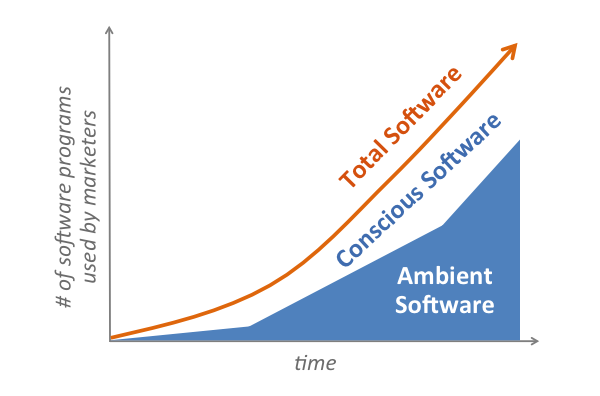
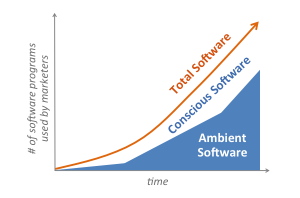

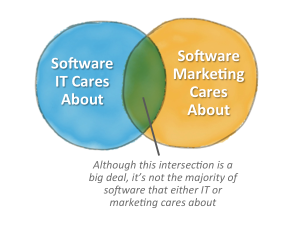
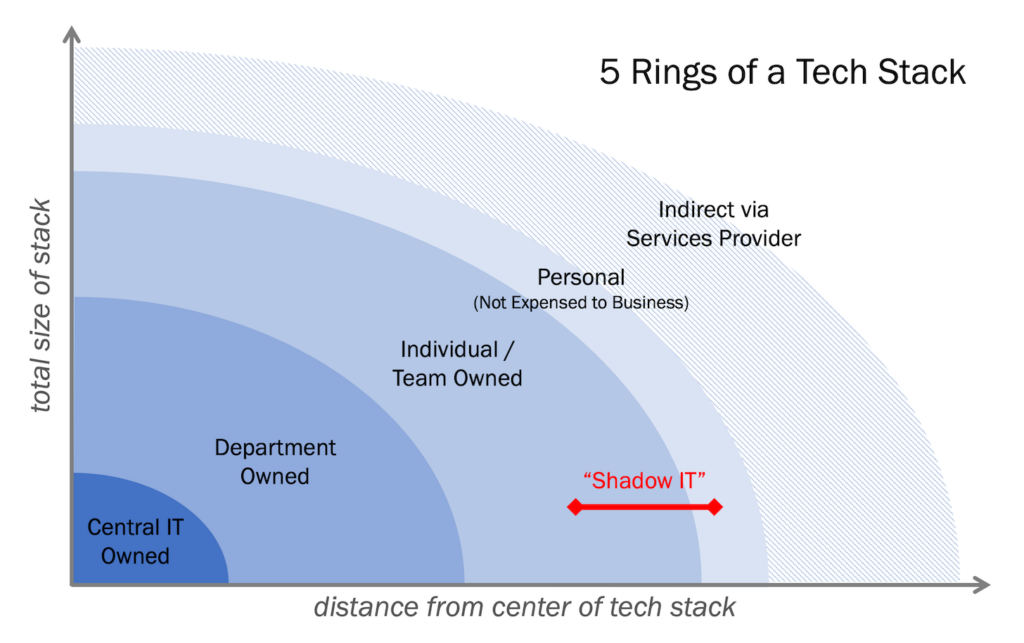

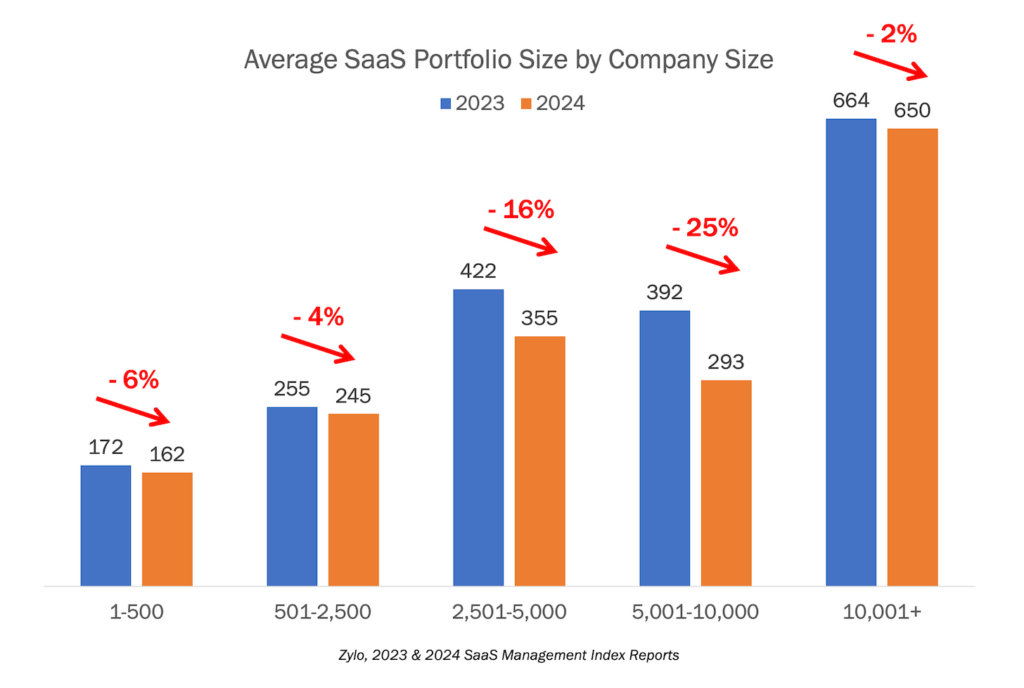
Hey Scott – my favorite posts from you are like this one – they predict the future. I love the idea that effortless user experiences and “ambient software” reduce the forces that might otherwise lead to market convergence. And I agree that loosely-coupled integrations suffice for a lot of marketing software. But doesn’t this lack of interdependence lead competitors to employ dominance strategies (http://en.wikipedia.org/wiki/Strategic_dominance) that ultimately lead to market convergence? I agree with all the points you make about the forces discouraging market convergence here, but I think of this one as a countervailing force pushing in the opposite direction. And it makes the future feel a bit less certain to me. You are so thoughtful on this topic, I’d love to read your perspective on this additional dimension of the issue. 🙂
Thanks, Brad. How can I not love a comment that questions the game theory at work behind all this stuff? 🙂
The point I was trying to make with this post — and I may have lost it somewhere in my rambling — is that what we explicitly think of as “marketing software” (MAP, CRM, CMS, etc.) is actually just a small part of the rich, diverse, and growing ecosystem of software that’s entwined in the lives of marketers.
I fully believe that we will see consolidation among major marketing platforms — indeed, it’s already happening. But that the number of software programs of all kinds, big, small, personal, group, ambient, conscious, etc., will continue to expand and innovate for the foreseeable future.
Actually, I believe the consolidation of core marketing platforms will help this, as these more standardized platforms will make it easier for specialized software to plug into the mesh. And for most of those apps, a loose-coupling to that backbone will suffice.
Love the game theory references here.
Agile CRM is a prime example of your points, Scott. We’re the first CRM to include a complete marketing automation suite – essentially a consolidation of multiple functions – but that doesn’t mean that our users ignore specialized traffic-related software (Unbounce, for example), specialty software for the finance department (Xero, Quickbooks) or, most significantly, killer new apps such as Zapier, which is pushing the automation landscape into a whole new dimension. The best new products increase value across the board, both in the core product itself and in the effectiveness and potential of relevant integrations.